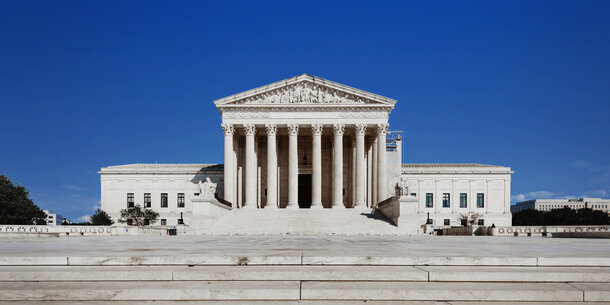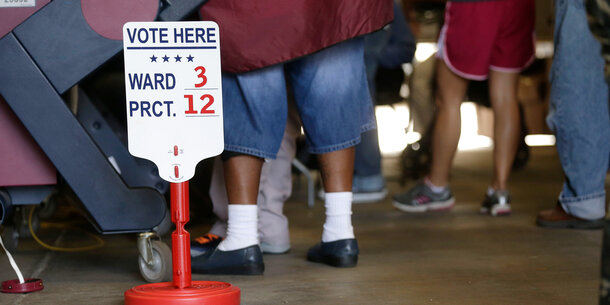As of the 2024 election, Arizona was the only state that required Americans to provide a birth certificate, passport, or other information proving their U.S. citizenship when they first registered to vote. Because such a requirement violates federal law for federal elections, Arizona’s law only applies to state and local elections. As a result, Americans who don’t have that kind of document (and many millions don’t) can still register and vote in federal elections in Arizona — they’re called “federal-only voters.” After reviewing Arizona’s voter file, we found that the federal-only voters are more likely to be younger, nonwhite, independent voters located in lower-income and less educated neighborhoods compared with the rest of the electorate.
In the 2024 elections, Arizona was the only state with a citizenship documentation requirement. It therefore provides a unique opportunity to evaluate the effects of the policy. Our analysis builds on reports from Votebeat, which found that the voters excluded from Arizona’s state elections tend to be concentrated near college campuses, are younger than the rest of the electorate, and are concentrated on tribal lands.
We obtained a copy of the registered voter file, which contains information about all registered voters, including whether they’ve provided citizenship documents and can thus cast a ballot in state elections. As of December 2024, there were almost 34,000 actively registered federal-only voters — far exceeding Gov. Katie Hobbs’s winning margin of 17,117 votes in the 2022 gubernatorial election. Nearly 8,000 of the federal-only voters cast a ballot last November. Each of them was blocked from having their voice heard when it came to their state legislative and supreme court races.
Using a statistical process called Bayesian Improved Surname Geocoding, we estimated the race of each registered voter in Arizona. We found significant racial disparities between the voters who are excluded from state elections and those who are not. Voters of color make up 54 percent of the federal-only voters in Arizona, even though they represent only 36 percent of the rest of the electorate. Latino voters are especially likely to be left out of state elections, as they make up 37 percent of the federal-only voters, compared with just 25 percent of voters who can vote in all elections in Arizona. Black voters make up nearly twice as much of the federal-only electorate as of the rest of the electorate (8.9 percent versus 4.7 percent).
Like Votebeat, we also found that the federal-only voters are considerably more likely to be politically independent. Only 45 percent of them are registered Democrats or Republicans, compared with 65 percent of the rest of the electorate. This is almost entirely because the federal-only voters are less than half as likely to be Republican, with Republicans making up only 17 percent of federal-only voters compared with 36 percent of federal-and-state voters. The federal-only voters are also about 13 years younger, on average, than the rest of the electorate.
Additionally, we looked at the neighborhoods that federal-only voters live in, compared with the rest of the electorate. While we can’t get individual-level income and education data from the voter file, we can learn a lot about these voters from their home census block group. We found that the average federal-only voter lives in a census block group where the median income is $72,000, compared with about $94,000 for the average state-and-federal voter. Federal-only voters also live in areas where college degrees are less common. The average federal-only voter lives in a census tract where 30 percent of the population has a four-year degree or higher, compared with state-and-federal voter neighborhoods where 35 percent of residents have at least a four-year degree.
It’s important to note that these income and education disparities aren’t independent of race — racial and ethnic minorities are more likely to be low-income than white Arizonans. But even when we account for voters’ county, age, party, neighborhood income, and neighborhood education rates using regression analysis, voters of color are still more likely to be excluded from participating in state elections.
In a lot of ways, Arizona’s law is similar to the SAVE Act being considered in Congress. The SAVE Act would also require voters to provide a birth certificate, passport, or other citizenship document to register to vote, but it is even more restrictive than Arizona’s law. In Arizona, voters only have to prove their citizenship the first time they register to vote in the state, while the SAVE Act would require Americans to show their documents every time they register to vote, which in many jurisdictions would include re-registrations and changes of address after a move. Arizona also allows voters to register online and submit copies of their citizenship documents, whereas the SAVE Act would require voters to present physical documentation in person, and it does not consider the possibility of photocopies. The SAVE Act also includes criminal penalties for election officials who register someone who hasn’t provided documentary proof of citizenship (even if the person actually is a citizen), unlike Arizona law. Given these differences, the voter exclusion seen in Arizona likely understates the harm that could come from Congress passing the even harsher requirements proposed in the SAVE Act.
Methodological Notes
Our numbers differ slightly from those reported by Votebeat due to different voter file snapshot dates. Our snapshot reflects the electorate as of December 4, 2024.
We ran Bayesian Improved Surname Geocoding at the block group level, using the citizen voting-age population for the population distributions.
Last fall, it came to light that about 200,000 registered voters in Arizona had not shown their citizenship papers but were nonetheless allowed to vote in state elections. That’s not because they were allowed to register in violation of the law but because they were registered before Arizona’s show-your-papers rule became law. Because they have been allowed to vote in state elections since the law was passed, we include them in our analysis here with the non-federal-only electorate. Of course, some of these individuals likely do not have easy access to their citizenship papers, though we do not know who. We therefore reran our analysis, excluding these 200,000 voters entirely. When we did so, our results were materially unchanged.







